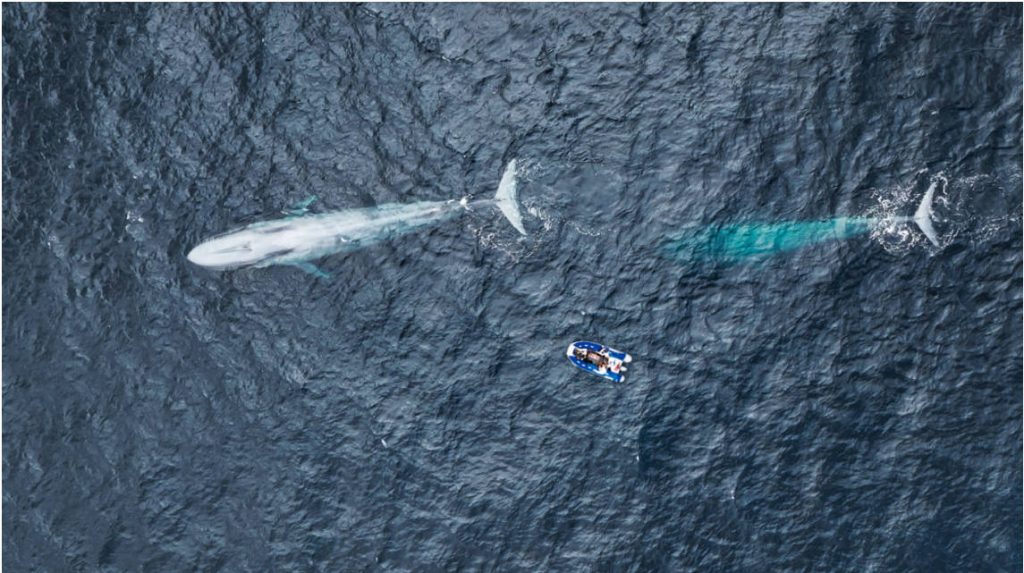Universidad San Francisco de Quito (Ecuador) The Importance Of Citizen Science To Better Understand Cetaceans In Galapagos

During the month of September 2021, Daniela Alarcón, a researcher at the Galapagos Science Center, and Héctor Guzmán, a scientist at the Smithsonian Tropical Research Institute, set out for the first time to tag blue whales off the coast of the Galapagos Islands with the main objective of learning about these species.
Daniela and her team focused on analyzing the citizen science data of the Galapagos Cetacean Program, continuing their field work by taking biopsy samples, along with photographic and video recording with drones, to later analyze them in the laboratory, and ensure associations. to expand into new research techniques such as acoustic monitoring and sample analysis.
10 years collecting information on whales and dolphins in the Galapagos
In 2010, Judith Denkinger and scientists from the Galapagos Science Center initiated the Galapagos Cetacean Program as a joint research initiative with the Galapagos National Park Directorate. The main objective of the project is to collect scientific information on whales and dolphins in the Galapagos.
A year later, in 2011, Daniela completed her thesis in Marine Ecology at the San Francisco de Quito University (USFQ), where she studied the abundance and distribution of cetaceans in an important channel west of the Galapagos.
When the COVID-19 pandemic began, Daniela and her team looked at data collected over ten years. “The pandemic caused the project to be suspended and the citizen science data that was collected at that time decreased, due to the lack of tourists on the islands, so we decided to take all the information we had and analyze the local diversity and temporality. of cetaceans, and that they could tell us such data”, commented Daniela.
Citizen Science is defined as the active and collaborative participation of the public in scientific research for the generation of knowledge. Through it, people generate and share information that contributes to research and monitoring projects.
The Galapagos Cetacean Program has collected data for several years on the diversity, distribution and temporality of cetacean species located around the archipelago thanks to the involvement of citizens, especially naturalist guides and visitors.
The objectives of the research this year were to analyze the data obtained on the species of cetaceans sighted, identify the place within the Galapagos Marine Reserve where they are found, and observe how the Galapagos community and tourists contribute to the protection and care of Cetacean marine life.
To complement and continue the information collected through citizen science, the team looks for cetaceans in two ways: “Either we take a boat for several days, or we just take a small fishing boat and go around a part of the island. Mainly, we use photographs to identify individuals and drones to measure them. We count the groups, we record any type of behavior that we see and we take biopsy samples,” said Daniela. Through the flight of drones, measurements of the length and width of the whales are collected, which would be difficult to estimate from a ship or from the ground.
“The images we take with our drones provide a reference size of the species and allows us to compare body conditions for the season. Since La Niña events provide productive waters, the hypothesis is that the animals will be fatter compared to less productive seasons,” said Daniela.
New Collaborations
The work team is made up of veterinarians, engineers and other cetacean specialists. The new collaborations enhance the research that Daniela and her team carry out. These collaborations include new perspectives for citizen science data analysis and during field trips.
The project is supported by a group of veterinarians from North Carolina State University, under the supervision of Dr. Diane Deresienski and Dr. Greg Lewbart, who take basic sample data, focusing on health assessments of the dolphin species.
Daniela has also been working in collaboration with Alessandro Bocconcelli of the Woods Hole Oceanographic Institution, to analyze cetacean vocalizations, mainly focusing on blue whales, through passive acoustic monitoring. This technique consists of installing sound recorders, without the researcher interfering in the ecosystem. “The vocalizations can help us determine which cetacean species we are hearing and even to which population they belong,” said Daniela.
After several years of searching and recording cetaceans in the Galapagos, the data being gathered shows how these giants are using marine ecosystems. Of the 26 species of cetaceans recorded in the Galapagos, the data shows that only 19 species have been sighted since 2010, fluctuating over the years depending on ocean conditions. Also, some species of dolphins that used to be common in the area are now rarely reported, while there has been an increase in sightings of other species such as blue whales and orcas.
“It is important to standardize the data collection process due to the importance of Galapagos in terms of species diversity. We want to include more citizens in the conservation science process. In the long term, citizen science could be the main source of collection of these data. We prioritize working with local people to include them as part of the scientific community,” said Daniela.
As part of the outreach efforts to communicate and encourage joining her citizen science initiative, Daniela presented her research at the “V Congress of Mammalogy in Ecuador”, among other seminars in which she has had the opportunity to participate.
In the future, Daniela and her team will continue to study the species and populations of cetaceans that frequent the waters of the Galapagos Islands, they will continue to collect data on climate changes in relation to the La Niña and El Niño phenomena, they will observe where they are headed and where the cetaceans that come to the archipelago come from, and they will analyze the state of health of these species and their marine environment.
